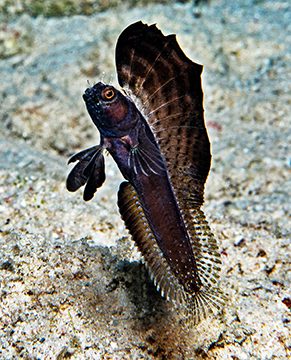OF ALL THE FISHES IN THE SEA THAT ANNA ADORES, blennies perch high atop her favorites list. Her fascination with the tribe of typically small, hole-inhabiting bottom-dwellers dates to the mid-1990s in the Bahamas at the kickoff of our fish-watching careers. Having a small boat, a seaside cottage, and the luxury of time, we set about investigating the complex nature of the islands’ marine life with the fervor of greenhorns.
Sweeping schools of snapper and grunts, legions of wrasses, and clouds of plankton-picking chromis greeted us on the reef each morning. But Anna’s sharp eyes, inherently attuned to the obscure, quicky discovered loveable, Muppet-faced blennies peeking out from the broken shadows of the seafloor. She was smitten.
During that first spring in Bimini, a group of volunteer divers from the recently organized Reef Environmental Education Foundation (REEF) joined us for a week to hone their fledgling fish surveying and identification skills. On the afternoon of our second day of diving the reef, an unexpected easterly storm sent us scurrying for calm water behind South Bimini’s rocky southern tip. Even though the shallow, algae-pocked inshore shallows of hardpan, rubble, and sand appeared bleak and unpromising, we decided to give it a go. With pencils and slates in hand, our group of a dozen divers tumbled off the boat and fanned out across the seemingly barren bottom as the sky darkened and rain began pelting the surface above.
Just as we feared, the few fish we could see in the dim surroundings tended to be nondescript and difficult to identify. As I considered abandoning the dive, a hand shot up, waving a yellow slate. The team converged around the hero of the moment and waited in suspense to discover what treasure she had uncovered. It wasn’t long before a dark, 2-inch (5-centimeter) silhouette powered by a thrashing tail soared above the bottom with a spectacular, oversized dorsal fin unfurled in all its glory. As if on cue, other high-flying sailfin blennies took up the cause.
Soon the surrounding bottom pulsed with nuptial males demanding the attention of a scattering of bottom-colored females slinking through the algae-like illusions. When a female crept close, the males went nuts, rising out of their holes with their fins fluttering in a ritualistic display of seduction, showcasing their health, vigor, size, and beauty. Occasionally, in a state of mischief, the males made mad dashes across the bottom to displace rivals living close to females in furious bouts of mouth-to-mouth combat reminiscent of Jurassic Park.
A half hour passed before the irresistible blenny show slowly came to an end as the colony of maybe 30 sailfins disappeared inside their shelter holes. The surveyors, dumbstruck with their luck, reluctantly returned to their task.
I hadn’t gone far when I felt a tug. It was Anna, gesturing for me to follow. She led me straight into the surge right up to the shoreline, where our bellies bumped bottom and our tanks broke the surface. Bracing herself against an oncoming wave, she pointed toward the rock-lined shore. I squinted, blinked, and stared but couldn’t see a thing until my eyes finally locked on a dark, dime-sized blenny head peering back at me with big, round, independently rotating eyes. It was a species I’d never seen. I carefully jotted down its features to help identify it from field guides later.
No sooner had I finished than Anna was waving again. Half slithering and half crawling, I arrived at her side in time to see another unfamiliar blenny dodge inside an abandoned barnacle casing. Anna’s excitement attracted others. Soon the boatload of surveyors was bumbling along the shoreline in a quest for blennies. By the time we made it back to the boat, our one-hour dive had stretched into two, the storm had passed, and the sun was setting as everyone talked at once about the best dive ever while eagerly flipping through identification books.
Later that evening, well after dinner, we were still telling and retelling tales from our epic blenny hunt. It wasn’t just the five unfamiliar blennies or novel shore fishes we encountered that made the dive so special. What we learned about the craft of fish watching on that dive has endured over the ensuing decades, beginning with a new respect for alternate habitat diving.
We also gained a real-world understanding of the term “search image.” Before Bimini, we probably swam above hundreds of sailfins, oblivious to their presence. But after spending time with sailfins, or any other cryptic species, in their natural habitat and acquiring an idea of their size, colors, and behavior, it becomes exponentially easier to find the same animal the next time around. Best of all, we discovered the joy of sharing a fascination for marine life — especially blennies — with fish-watching friends.

In a flurry of fins, a nondescript, hole-dwelling male sailfin blenny transforms himself into a high-flying Casanova in a spirited attempt to attract a female perched a few feet away.
Soon the surrounding bottom pulsed with nuptial males demanding the attention of a scattering of bottom-colored females slinking through the algae-like illusions.
© Alert Diver — Q2 2022